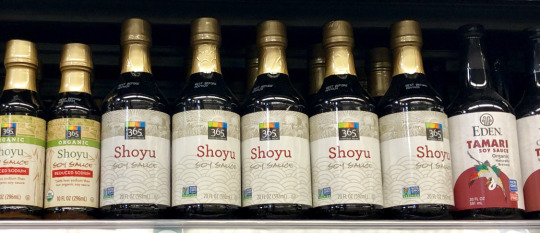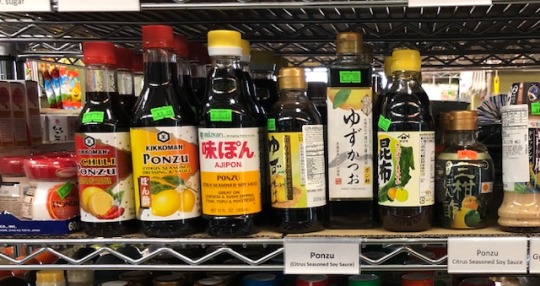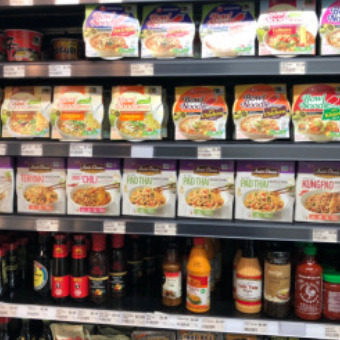#culinarycuisine
Explore tagged Tumblr posts
Text
Soy Sauce: Salty Misconceptions
As an Asian American woman, I have grown to connect with and appreciate my heritage through food. While I enjoy fried chicken and steak, I also enjoy having a nice bowl of 牛肉面 (niu rou mian=beef noodle soup) and 米粥 (mi zhou= rice congee). Despite indulging in both American and Chinese cuisines, I was brought up with the notion that to have real Chinese food, one had to go to Asian grocery markets and Chinese restaurants. Simply put, going to Panda Express or Walmart was a sin in my house. For my anthropological fieldwork grocery project, I chose to investigate how soy sauce, a preconceived international food by Western consumers, is marketed on American shelves.
Soy sauce (shoyu in Japanese) originated in China roughly 2,200 years ago and is believed to have been introduced to Japan by a Buddhist monk in the mid-13th century (Stein and Shibata). It is made from soybeans, wheat, salt, and water that is fermented in a four year process. The ingredients are not the make it or break it of a good soy sauce, but rather its production environment. Traditional Japanese brewers use koike or specially crafted wooden vessels to ferment the soybeans. The grains of the wood enrich the millions of microbes that deepen the fermentation to produce a savory umami flavor.
However, most modern-day soy sauces are produced within stainless steel vats that shorten the multi-year fermenting process to just three months. Because the bacteria produced in koikes cannot survive in steel tanks, many commercial companies pump their soy sauces with additives like monosodium glutamate or MSG in order to keep up with the demand and production of soy sauce--something I would discover to be true during my project.

During the spring of 2019, I examined soy sauce brands across 4 grocery stores in the Washington, D.C. area. My research was conducted through participant observation, which involves walking around the store as a potential customer and observing the ambiance of the store and its customers, while taking note of the location and sensory details of the soy sauce options offered. I conducted optical research as I observed my surroundings without personal interviews. Over the course of a semester, I learn that soy sauce, in its labeling and aisle surroundings, has been modified to fit into Western perceptions of Asian cuisine--revealing deeper connotations behind its ingredients and authenticity.
My first store visit was at the Whole Foods Market in the Foggy Bottom campus of the George Washington University. I paid close attention to the logos of each brand, nitpicking the logos for its embodiment of Asian culture through symbols like bamboo shoots and cranes. I later observed the design was not the most striking element, but rather the emphasis on reduced sodium and non-GMO ingredients.
Every bottle addressed it through writing, logos, or both. Health reasons aside, I came into this project with a preconceived notion that buying soy sauce from an American grocery store equated to not only buying from a market that addressed negative connotations of an Asian cuisine but also one that implied Chinese manufacturers were careless for placing MSG in their products.
Talk of Asian cuisine being too salty or not healthy for consumers was rarely discussed in my family nor did Asian food markets I went to as a child address it in the labelling. Seeing this language on American-brand soy sauce bottles made me feel culturally isolated as someone who had Chinese food almost every day of her life.

I visited Hana Japanese Market to see if the same language of reduced sodium appeared on its bottles. Hana Market is on the first floor of a quaint gray townhouse in a quiet neighborhood on U Street. I not only found Japanese-imported soy sauce on the bottom shelf, but also the American brands with reduced sodium and non-GMO stickers were on the shelf above. I was shocked to see the overall bottom placement of a renowned Japanese seasoning staple.
I wondered if it was because Hana’s store owners tailored their products towards the perceptions of Western customers--fully aware that MSG was a health concern and they had made efforts to address it. They even printed out English labels that said reduced sodium for the bottles written in Japanese. On an eye-level shelf, Hana offered ponzu or citrus “seasoned” (not flavored) soy sauce. I had never heard of ponzu until this site visit. To see traditional and authentic Japanese products at Hana made me feel more part of the Japanese culture and where we were borrowing this Asian cuisine from.

Visiting Safeway and Streets Market was a pivotal point in my research. The Safeway I visited in Georgetown was a superstore that focused on convenience and value. However, I was quickly appalled by the selection of soy sauces at Safeway. The soy sauces at Safeway were found in the “Asian/International” section. In the collage below, Safeway had big jugs of soy sauce that reminded me of gallons of gasoline. All options had cheap prices of $2-4. While the prices were tempting, La Choy proved that the quality was not worth it.
The bottle said “Inspired by Traditional Asian Cuisine”, yet its ingredients of hydrolyzed soy protein, corn syrup, caramel coloring, and potassium sorbate (a preservative) were quite the contrary. Might I add it was also produced in Omaha, Nebraska. After seeing the natural and traditionally brewed bottles that Whole Foods and Hana offered, La Choy was an insult to the traditional Japanese soy sauce brewers and the Asian culture itself.

Streets Market revealed a different connotation to how soy sauce was marketed. The store was located in a busy part of D.C., near the border of the Northeast sector. Prices at Streets were sky-high, yet the instant ramen noodles and ready-made “Asian” meals surrounding the soy tiny bottles of soy sauce did not portray Asian food as appealing. Streets perceived Asian food as an on-the-go and quick bite rather than a cuisine to be appreciated.
Perhaps this perception was why it took me 3 stores to locate a place with more than one type of soy sauce. Prior to Streets, I visited Trader Joe’s, Dean & DeLuca, and GWU’s Gallery Market only to discover they had one option. A bottle of soy sauce is not something to be consumed in a day, but I expected more variety. After my visit at Streets, with its array of plastic bowled and preservative-filled instant noodles, perhaps the purpose of soy sauce to Western consumers was nothing more than just a condiment that was put on things to make them saltier.

I went back to the Foggy Bottom Whole Foods for my final site report and was glad to see the wide selection of soy sauces with no worries of added preservatives. It gave me a greater appreciation for the store’s strides towards lower prices and high quality standards.
Above all, the Asian culinary identity was present in its surroundings and labelling. The International aisle lived up to its name as the soy sauce was next to Asian ingredients rather than instant bowls of ramen. Offering actual ingredients encouraged customers to make Asian dishes themselves, allowing for a greater appreciation of the Asian culture they are consuming. The labelling of bottles like San-J educated customers on the usage and meaning behind soy sauce.

My fieldwork has lead me to draw two conclusions on the implications surrounding the culture of Asian food in America. First, Asian cuisine is modified to fit the tastes of the” average American consumer”. Dishes like Kung Pao or General Tso’s chicken would never be found in China. When Panda Express was established in 1983, the Cherng family knew it would be difficult to for mainstream American customers, especially outside of metropolitan areas, to accept a Chinese dish in its original form and flavor (Liu, 138). Although its original flavor was salty and spicy, Andrew Cherng invented a new sweet and spicy orange sauce for chicken which allegedly came from Hunan cuisine in South China.
In addition, the famous P.F. Chang’s restaurant chain was named after restaurateurs Peter Flemming (PF) and Philip Chiang. However, “Chiang” was purposely changed into “Chang” in order to make the brand less foreign to the American public (Liu, 130). For many years, authentic Chinese food has had no market in America--pointing to a dangerous conception among many Americans that Chinese product owners are not in control of their own culture in the American food market. At the same time, food is both a culture and commodity. When food becomes a commodity, it is no longer an inherited culture as corporate America can easily appropriate it from the Chinese community (Liu 135).
Second, the use of MSG instead of soybeans in soy sauce points to a loss of authenticity in Japanese culture. The health dangers of replacing soybeans with artificial flavoring first occurred in the mid 20th century when Chairman Mao seized control of China in 1949. Perceptions of the Chinese changed as they were seen as threatening to US democracy. The association between Chinese food and health problems was an easy connection for Americans to adopt the Chinese Restaurant Syndrome or CRS (Germain, 2). People complained of having numbness in the back of the neck that gradually carried through the arms and back, leading to overall weakness.
CRS confirmed a pre-existing unease regarding the Chinese people during that time. Although MSG is also commonly used by manufacturers of processed foods like Doritos and KFC, it is inextricably tied to Chinese food. The consequences of CRS remain today, as demonstrated in my research, virtually almost all soy sauce bottles in the US have some sort of reduced sodium or no-MSG identification.
This project has taught me to appreciate the authenticity rather than the convenience of an international food. Culinary culture is a public domain in where everyone has the right to access or own it. Yet grocery stores need to remember that culture cannot be separated from tradition. It has to be respected. From the item’s placement in a store and on shelves, to its surroundings and design, more stores need to pay tribute to the culture from which their products migrate. Essentially, mixing caramel coloring, preservatives, and water is not Asian cuisine. And on that salty note, I sign off.
-- Caitlyn Phung
References
Liu, H. (n.d.). Who Owns Culture? In From Canton Restaurant to Panda Express: A History of Chinese
Food in the United States (pp. 128-145). Rutgers University Press.
Germain, Thomas. A Racist Little Hat: The MSG Debate and American Culture. Columbia Undergraduate Research Journal. 2017; 2:1. doi: 10.7916/D8MG7VVN
Stein, E., & Shibata, M. (2019, February 26). Is Japan losing its umami? Retrieved April 20, 2019,
from http://www.bbc.com/travel/gallery/20190225-a-750-year-old-japanese-secret
#authenticity#tradition#resepct#culinarycuisine#education#empowerment#encourage#commodity#MSG#reducedsodium#healthy#glutenfree#marketing#surroundings#aisles#international#asianfood#asian#Japanese#Chinese#cuisine#soysauce#soy#365#WFM#WholeFoods#foggybottom#gwu#HanaMarket#Safeway
5 notes
·
View notes
Photo

Beirut cooking festival 2017 ضمن فعاليات مهرجان بيروت للطهي #beirutcookingfestival #cookingsession #whatscookingbeirut #bcf2017 #cooking #chefs #foodlovers #ingredients #recipes #tasting #tasteandflavors #beirut #cheflife #chefconnected #lebanesechef #beirut #culinarycuisine #mediterraneanfood #internationalfood #food #concept #culinaryarts Hospitality Serv Salon Du Chocolat Beirut Taste and Flavors
#bcf2017#beirutcookingfestival#ingredients#culinarycuisine#chefs#mediterraneanfood#culinaryarts#whatscookingbeirut#cookingsession#cooking#cheflife#tasteandflavors#internationalfood#chefconnected#recipes#tasting#lebanesechef#foodlovers#food#concept#beirut
0 notes
Photo

Ritual hari Jumat kepala manyung sama bunga desa 🕵🏻 🌶🌶🌶 Makasih bulek untuk resepnya.? *lidah gw gak bs di bohongi. #culinaryculture #culinarycuisine #foodadventure #kepalamanyung (di Polres Pati)
0 notes
Video
youtube
Smart Cooking or in this case "Cook Smarts" new cook/health enthusiast Jess Dang is making things simple in the kitchen. Her company Cook Smarts which was started in 2011 focuses on inspiring, empowering, and educating anybody on the benefits of not just cooking but healthy cooking. Jess has been fascinated with cooking for as long as she can remember. Be sure to check out her website and sign up for the newsletter.
source: www.cooksmarts.com
1 note
·
View note
Photo

Beirut cooking festival 2017 ضمن فعاليات مهرجان بيروت للطهي #beirutcookingfestival #cookingsession #whatscookingbeirut #bcf2017 #cooking #chefs #foodlovers #ingredients #recipes #tasting #tasteandflavors #beirut #cheflife #chefconnected #lebanesechef #beirut #culinarycuisine #mediterraneanfood #internationalfood #food #concept #culinaryarts Hospitality Serv Salon Du Chocolat Beirut Taste and Flavors
#culinaryarts#whatscookingbeirut#recipes#food#chefs#cheflife#cookingsession#bcf2017#foodlovers#ingredients#beirut#tasteandflavors#culinarycuisine#concept#mediterraneanfood#chefconnected#internationalfood#beirutcookingfestival#lebanesechef#tasting#cooking
0 notes
Photo

Beirut cooking festival 2017 ضمن فعاليات مهرجان بيروت للطهي #beirutcookingfestival #cookingsession #whatscookingbeirut #bcf2017 #cooking #chefs #foodlovers #ingredients #recipes #tasting #tasteandflavors #beirut #cheflife #chefconnected #lebanesechef #beirut #culinarycuisine #mediterraneanfood #internationalfood #food #concept #culinaryarts Hospitality Serv Salon Du Chocolat Beirut Taste and Flavors
#bcf2017#cheflife#tasting#culinaryarts#whatscookingbeirut#chefs#cooking#mediterraneanfood#cookingsession#concept#internationalfood#culinarycuisine#chefconnected#lebanesechef#beirutcookingfestival#recipes#beirut#tasteandflavors#food#foodlovers#ingredients
0 notes
Photo

Beirut cooking festival 2017 ضمن فعاليات مهرجان بيروت للطهي #beirutcookingfestival #cookingsession #whatscookingbeirut #bcf2017 #cooking #chefs #foodlovers #ingredients #recipes #tasting #tasteandflavors #beirut #cheflife #chefconnected #lebanesechef #beirut #culinarycuisine #mediterraneanfood #internationalfood #food #concept #culinaryarts Hospitality Serv Salon Du Chocolat Beirut Taste and Flavors
#culinaryarts#lebanesechef#tasteandflavors#concept#cookingsession#ingredients#chefs#cheflife#culinarycuisine#internationalfood#food#cooking#recipes#beirutcookingfestival#whatscookingbeirut#bcf2017#mediterraneanfood#foodlovers#chefconnected#beirut#tasting
0 notes
Photo

Beirut cooking festival 2017 ضمن فعاليات مهرجان بيروت للطهي #beirutcookingfestival #cookingsession #whatscookingbeirut #bcf2017 #cooking #chefs #foodlovers #ingredients #recipes #tasting #tasteandflavors #beirut #cheflife #chefconnected #lebanesechef #beirut #culinarycuisine #mediterraneanfood #internationalfood #food #concept #culinaryarts Hospitality Serv Salon Du Chocolat Beirut Taste and Flavors
#tasteandflavors#beirut#culinaryarts#chefs#recipes#cooking#whatscookingbeirut#cookingsession#internationalfood#lebanesechef#culinarycuisine#bcf2017#ingredients#beirutcookingfestival#mediterraneanfood#cheflife#food#tasting#chefconnected#foodlovers#concept
0 notes
Photo

Beirut cooking festival 2017 ضمن فعاليات مهرجان بيروت للطهي #beirutcookingfestival #cookingsession #whatscookingbeirut #bcf2017 #cooking #chefs #foodlovers #ingredients #recipes #tasting #tasteandflavors #beirut #cheflife #chefconnected #lebanesechef #beirut #culinarycuisine #mediterraneanfood #internationalfood #food #concept #culinaryarts Hospitality Serv Salon Du Chocolat Beirut Taste and Flavors
#lebanesechef#cheflife#ingredients#beirutcookingfestival#cooking#concept#chefs#mediterraneanfood#food#recipes#tasting#bcf2017#whatscookingbeirut#beirut#cookingsession#culinaryarts#chefconnected#internationalfood#culinarycuisine#tasteandflavors#foodlovers
0 notes
Photo

Beirut cooking festival 2017 ضمن فعاليات مهرجان بيروت للطهي #beirutcookingfestival #cookingsession #whatscookingbeirut #bcf2017 #cooking #chefs #foodlovers #ingredients #recipes #tasting #tasteandflavors #beirut #cheflife #chefconnected #lebanesechef #beirut #culinarycuisine #mediterraneanfood #internationalfood #food #concept #culinaryarts Hospitality Serv Salon Du Chocolat Beirut Taste and Flavors
#mediterraneanfood#food#ingredients#cooking#cookingsession#beirut#chefconnected#tasting#beirutcookingfestival#whatscookingbeirut#lebanesechef#concept#recipes#foodlovers#cheflife#tasteandflavors#culinarycuisine#chefs#bcf2017#culinaryarts#internationalfood
0 notes
Photo

Beirut cooking festival 2017 ضمن فعاليات مهرجان بيروت للطهي #beirutcookingfestival #cookingsession #whatscookingbeirut #bcf2017 #cooking #chefs #foodlovers #ingredients #recipes #tasting #tasteandflavors #beirut #cheflife #chefconnected #lebanesechef #beirut #culinarycuisine #mediterraneanfood #internationalfood #food #concept #culinaryarts Hospitality Serv Salon Du Chocolat Beirut Taste and Flavors
#whatscookingbeirut#chefconnected#internationalfood#recipes#culinarycuisine#concept#lebanesechef#bcf2017#tasteandflavors#cooking#culinaryarts#foodlovers#chefs#beirutcookingfestival#beirut#cheflife#mediterraneanfood#food#cookingsession#tasting#ingredients
0 notes
Photo

Beirut cooking festival 2017 ضمن فعاليات مهرجان بيروت للطهي #beirutcookingfestival #cookingsession #whatscookingbeirut #bcf2017 #cooking #chefs #foodlovers #ingredients #recipes #tasting #tasteandflavors #beirut #cheflife #chefconnected #lebanesechef #beirut #culinarycuisine #mediterraneanfood #internationalfood #food #concept #culinaryarts Hospitality Serv Salon Du Chocolat Beirut Taste and Flavors
#internationalfood#chefs#food#ingredients#lebanesechef#chefconnected#whatscookingbeirut#cooking#concept#culinarycuisine#culinaryarts#recipes#foodlovers#cheflife#bcf2017#mediterraneanfood#beirutcookingfestival#beirut#tasting#cookingsession#tasteandflavors
0 notes
Photo

Beirut cooking festival 2017 ضمن فعاليات مهرجان بيروت للطهي #beirutcookingfestival #cookingsession #whatscookingbeirut #bcf2017 #cooking #chefs #foodlovers #ingredients #recipes #tasting #tasteandflavors #beirut #cheflife #chefconnected #lebanesechef #beirut #culinarycuisine #mediterraneanfood #internationalfood #food #concept #culinaryarts Hospitality Serv Salon Du Chocolat Beirut Taste and Flavors
#food#culinarycuisine#lebanesechef#foodlovers#whatscookingbeirut#cheflife#cooking#internationalfood#concept#mediterraneanfood#tasting#beirut#chefconnected#beirutcookingfestival#bcf2017#culinaryarts#cookingsession#chefs#tasteandflavors#ingredients#recipes
0 notes
Photo

Beirut cooking festival 2017 ضمن فعاليات مهرجان بيروت للطهي #beirutcookingfestival #cookingsession #whatscookingbeirut #bcf2017 #cooking #chefs #foodlovers #ingredients #recipes #tasting #tasteandflavors #beirut #cheflife #chefconnected #lebanesechef #beirut #culinarycuisine #mediterraneanfood #internationalfood #food #concept #culinaryarts Hospitality Serv Salon Du Chocolat Beirut Taste and Flavors
#cookingsession#bcf2017#recipes#internationalfood#cooking#beirutcookingfestival#beirut#concept#culinaryarts#cheflife#food#chefs#foodlovers#tasting#mediterraneanfood#chefconnected#whatscookingbeirut#culinarycuisine#ingredients#lebanesechef#tasteandflavors
0 notes
Photo

Beirut cooking festival 2017 ضمن فعاليات مهرجان بيروت للطهي #beirutcookingfestival #cookingsession #whatscookingbeirut #bcf2017 #cooking #chefs #foodlovers #ingredients #recipes #tasting #tasteandflavors #beirut #cheflife #chefconnected #lebanesechef #beirut #culinarycuisine #mediterraneanfood #internationalfood #food #concept #culinaryarts Hospitality Serv Salon Du Chocolat Beirut Taste and Flavors
#internationalfood#concept#mediterraneanfood#whatscookingbeirut#culinarycuisine#cookingsession#food#chefs#tasting#recipes#cooking#chefconnected#bcf2017#lebanesechef#beirut#culinaryarts#beirutcookingfestival#foodlovers#ingredients#cheflife#tasteandflavors
0 notes
Photo

Beirut cooking festival 2017 ضمن فعاليات مهرجان بيروت للطهي #beirutcookingfestival #cookingsession #whatscookingbeirut #bcf2017 #cooking #chefs #foodlovers #ingredients #recipes #tasting #tasteandflavors #beirut #cheflife #chefconnected #lebanesechef #beirut #culinarycuisine #mediterraneanfood #internationalfood #food #concept #culinaryarts Hospitality Serv Salon Du Chocolat Beirut Taste and Flavors
#chefconnected#food#beirut#lebanesechef#whatscookingbeirut#cookingsession#tasting#internationalfood#recipes#tasteandflavors#chefs#bcf2017#concept#culinarycuisine#beirutcookingfestival#cooking#cheflife#foodlovers#culinaryarts#ingredients#mediterraneanfood
0 notes